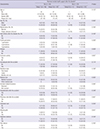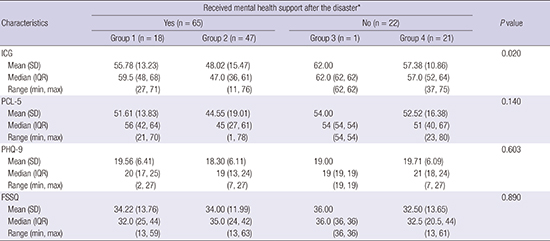1. Paik JW, Kim HS, Sim M, Lee HK, Woo YS, Chung C, Lee SH, Seok JH, Jeon HJ, Lee SM, et al. The Sewol Ferry accident and early mental health care response by volunteer activities of Korean Disaster Mental Health Committee and members of Korean Neuropsychiatric Association. J Korean Neuropsychiatr Assoc. 2015; 54:1–5.
2. Han H, Choi W, Huh S, Heo HJ, Chae JH. Understanding of complicated grief. Cognitive Behav Ther Korea. 2016; 16:383–401.
3. Meert KL, Shear K, Newth CJ, Harrison R, Berger J, Zimmerman J, Anand KJ, Carcillo J, Donaldson AE, Dean JM, et al. Follow-up study of complicated grief among parents eighteen months after a child’s death in the pediatric intensive care unit. J Palliat Med. 2011; 14:207–214.
4. Currier JM, Holland JM, Neimeyer RA. Sense-making, grief, and the experience of violent loss: toward a mediational model. Death Stud. 2006; 30:403–428.
5. Nakajima S, Ito M, Shirai A, Konishi T. Complicated grief in those bereaved by violent death: the effects of post-traumatic stress disorder on complicated grief. Dialogues Clin Neurosci. 2012; 14:210–214.
6. Wilson DM, Dhanji N, Playfair R, Nayak SS, Puplampu GL, Macleod R. A scoping review of bereavement service outcomes. Palliat Support Care. 2017; 15:242–259.
7. Wittouck C, Van Autreve S, De Jaegere E, Portzky G, van Heeringen K. The prevention and treatment of complicated grief: a meta-analysis. Clin Psychol Rev. 2011; 31:69–78.
8. Lee N, Sim K, Hahn S, Lee K, Sim M, Chae JH, Ahn H. A qualitative content analysis of reports of mental health service providers after the Sewol Ferry accident in Korea. Ment Health Soc Work. 2015; 43:116–144.
9. Gyeonggi-do Ansan-si Integrated Disaster Metal Health Support Team (KR). Disaster Mental Health Support for 14 Days after the Sewol Ferry Accident. Suwon: Gyeonggi Provincial Mental Health Center;2014.
10. Ogrodniczuk JS, Joyce AS, Piper WE. Changes in perceived social support after group therapy for complicated grief. J Nerv Ment Dis. 2003; 191:524–530.
11. Prigerson HG, Maciejewski PK, Reynolds CF 3rd, Bierhals AJ, Newsom JT, Fasiczka A, Frank E, Doman J, Miller M. Inventory of complicated grief: a scale to measure maladaptive symptoms of loss. Psychiatry Res. 1995; 59:65–79.
12. Hoge CW, Riviere LA, Wilk JE, Herrell RK, Weathers FW. The prevalence of post-traumatic stress disorder (PTSD) in US combat soldiers: a head-to-head comparison of DSM-5 versus DSM-IV-TR symptom criteria with the PTSD checklist. Lancet Psychiatry. 2014; 1:269–277.
13. Kroenke K, Spitzer RL, Williams JB. The PHQ-9: validity of a brief depression severity measure. J Gen Intern Med. 2001; 16:606–613.
14. Manea L, Gilbody S, McMillan D. Optimal cut-off score for diagnosing depression with the patient health questionnaire (PHQ-9): a meta-analysis. CMAJ. 2012; 184:E191–E196.
15. Broadhead WE, Gehlbach SH, de Gruy FV, Kaplan BH. The Duke-UNC functional social support questionnaire. Measurement of social support in family medicine patients. Med Care. 1988; 26:709–723.
16. Burke LA, Neimeyer RA, McDevitt-Murphy ME. African American homicide bereavement: aspects of social support that predict complicated grief, PTSD, and depression. Omega (Westport). 2010; 61:1–24.
17. Bonanno GA, Wortman CB, Lehman DR, Tweed RG, Haring M, Sonnega J, Carr D, Nesse RM. Resilience to loss and chronic grief: a prospective study from preloss to 18-months postloss. J Pers Soc Psychol. 2002; 83:1150–1164.
18. Boelen PA, de Keijser J, van den Hout MA, van den Bout J. Treatment of complicated grief: a comparison between cognitive-behavioral therapy and supportive counseling. J Consult Clin Psychol. 2007; 75:277–284.
19. Reynolds CF 3rd, Miller MD, Pasternak RE, Frank E, Perel JM, Cornes C, Houck PR, Mazumdar S, Dew MA, Kupfer DJ. Treatment of bereavement-related major depressive episodes in later life: a controlled study of acute and continuation treatment with nortriptyline and interpersonal psychotherapy. Am J Psychiatry. 1999; 156:202–208.
20. Rosner R, Bartl H, Pfoh G, Kotoučová M, Hagl M. Efficacy of an integrative CBT for prolonged grief disorder: a long-term follow-up. J Affect Disord. 2015; 183:106–112.
21. Shear K, Frank E, Houck PR, Reynolds CF 3rd. Treatment of complicated grief: a randomized controlled trial. JAMA. 2005; 293:2601–2608.
22. Smid GE, Kleber RJ, de la Rie SM, Bos JB, Gersons BP, Boelen PA. Brief eclectic psychotherapy for traumatic grief (BEP-TG): toward integrated treatment of symptoms related to traumatic loss. Eur J Psychotraumatol. 2015; 6:27324.
23. Weissman MM, Markowitz JC, Klerman GL. Comprehensive Guide to Interpersonal Psychotherapy. New York, NY: Basic Books;2000.
24. Zygmont M, Prigerson HG, Houck PR, Miller MD, Shear MK, Jacobs S, Reynolds CF 3rd. A post hoc comparison of paroxetine and nortriptyline for symptoms of traumatic grief. J Clin Psychiatry. 1998; 59:241–245.
25. Hensley PL, Slonimski CK, Uhlenhuth EH, Clayton PJ. Escitalopram: an open-label study of bereavement-related depression and grief. J Affect Disord. 2009; 113:142–149.
26. Simon NM, Shear MK, Fagiolini A, Frank E, Zalta A, Thompson EH, Reynolds CF 3rd, Silowash R. Impact of concurrent naturalistic pharmacotherapy on psychotherapy of complicated grief. Psychiatry Res. 2008; 159:31–36.







 PDF
PDF ePub
ePub Citation
Citation Print
Print




 XML Download
XML Download